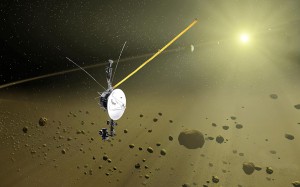 Voyager 1 is the ultimate Gen-X spacecraft. It grew up with us—launched in 1977, coming into its adolescence in the Eighties with storied fly-bys of the outer planets, then moving out, as it were, in the years and decades that followed.
Voyager 1 is the ultimate Gen-X spacecraft. It grew up with us—launched in 1977, coming into its adolescence in the Eighties with storied fly-bys of the outer planets, then moving out, as it were, in the years and decades that followed.
It’s easy to forget that Voyager 1, and its twin, Voyager 2, are still out there. But they very much are—still faithfully carrying out their missions, and still phoning home. Actually, their official mission profiles ended in ’89, but the plutonium-powered crafts were still going strong, so NASA pointed them toward interstellar space and bid them farewell. Voyager 1 is now over 11 billion miles from home, with its communications taking more than 17 hours to reach earth.
Voyager 1 reached an historic milestone last month, finally confirmed by its transmitted telemetry. Its on-board instrumentation detected for the first time a sudden lack of nearby charged particles, which can only mean that it is no longer in the heliosphere.
Another way of saying that is, Voyager 1 is now the only known man-made object to exit our solar system.
You may or may not appreciate how momentous that is. Perhaps the following will bring it home: On two recent occasions, Voyager 1′s plasma sensors detected vibrations in the dense ionized gas of space. Although “sound,” as we understand it, requires an atmosphere for transmission, the plasma medium that carried these vibrations is a close enough substitute that the spacecraft was able to record it. I’ve embedded the recording below.
For the first time in your life—for the first time in the history of our species—you can listen to the (appropriately eerie) sounds of interstellar space: